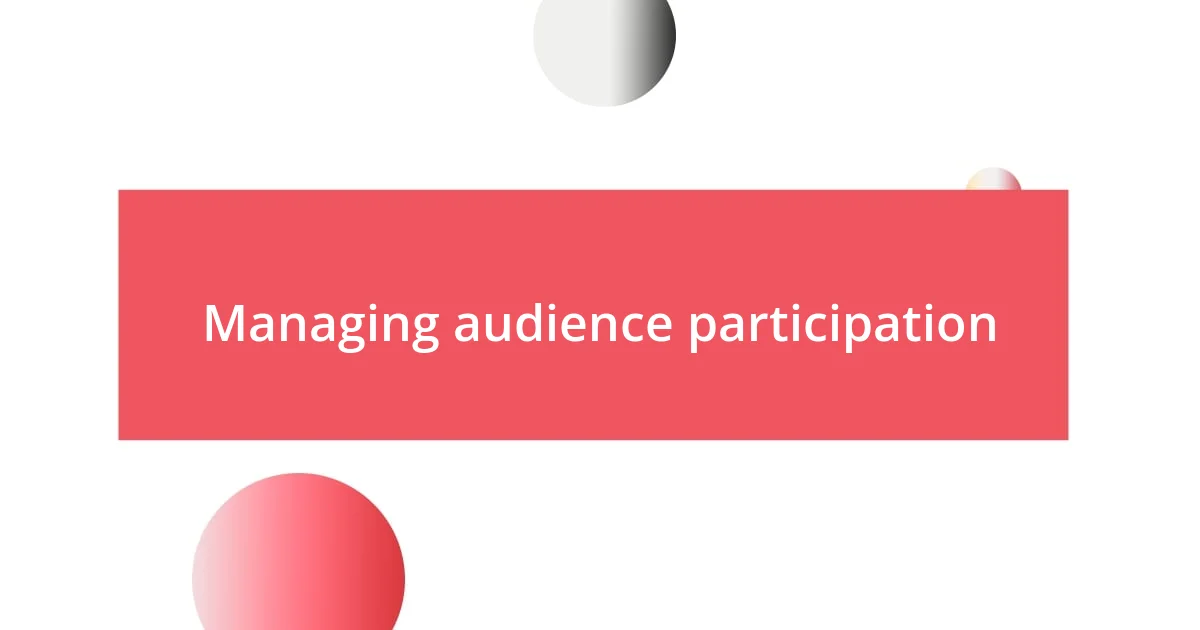Key takeaways:
- Importance of preparation: Thorough research, understanding panelists, and clear objectives are critical for fostering engaging discussions.
- Selection of panelists: A diverse mix of expertise, communication styles, and relatability enhances dialogue and creates a collaborative atmosphere.
- Effective audience management: Encouraging participation and utilizing technology can transform discussions, while emotional intelligence helps navigate sensitive topics.

My background in discussion panels
Throughout my journey, I’ve found myself stepping into the role of a discussion panel leader on multiple occasions. One memorable experience was during a university event, where I tackled the nuances of mental health in academia. I still remember the nervous excitement as I took the stage, realizing that my voice could facilitate a vital conversation for so many.
Leading these discussions hasn’t always been easy. There were moments when the dialogue became tense and emotions ran high, which challenged my ability to maintain a calm and respectful atmosphere. I often ask myself: how can I foster a sense of safety while encouraging openness? It’s a delicate balance, but those moments shaped my approach, teaching me the importance of empathy in guiding conversations.
With each panel, I’ve grown more confident in curating diverse perspectives. One time, I brought together individuals from varying backgrounds to debate technology’s role in education. Seeing people’s light bulbs go off as they connected the dots between their experiences was exhilarating. It made me realize how enriching a well-facilitated discussion can be, not just for the audience, but for me as a leader as well.

Preparing for the discussion panel
Preparing for a discussion panel involves meticulous planning and personal reflection. I remember one time, weeks before the event, I spent hours mapping out potential topics and questions that could spark engaging dialogue. It’s about understanding not just the subject matter, but also the unique dynamics of your panelists and audience.
Here are some key steps I found valuable during this preparation stage:
- Research the Topics: Dive deep into the subject to form insightful questions and counterpoints.
- Know Your Panelists: Familiarize yourself with their backgrounds, interests, and previous discussions to engage them effectively.
- Draft a Flexible Outline: Create a structure that allows for spontaneity—some of the best discussions emerge from unexpected threads.
- Anticipate Challenges: Consider possible disagreements and prepare strategies to navigate those moments gracefully.
- Set Clear Objectives: Think about what you want your audience to take away; clarity in purpose can guide the conversation significantly.
Ultimately, every panel might demand a slightly different approach, but maintaining a connection to the humanity behind each discussion is what truly resonates with me. It’s that sense of purpose—those sparks of connection—that drives my preparation.

Selecting the right panelists
Selecting the right panelists can significantly influence the success of a discussion. It’s essential to consider a blend of expertise, perspective, and communication style. I once curated a panel where I intentionally included speakers from various fields—community leaders, academics, and even a local activist. The energy in that discussion was electrifying; each panelist brought a unique angle, enriching the dialogue and deepening the audience’s understanding.
Another critical point to keep in mind is the chemistry among panelists. I recall a panel I moderated that struggled with interaction because the speakers had very different approaches to conversation. Some were more reserved, while others thrived on banter. As I watched that exchange unfold, it became clear that fostering a collaborative atmosphere is crucial. When panelists resonate with one another, it fosters an environment where ideas can spark and flourish, ultimately benefiting everyone involved.
Lastly, consider the audience’s connection with the panelists. It’s vital to choose individuals who can engage and relate to the audience in meaningful ways. During one of my events focused on youth empowerment, I selected panelists who not only had expertise but also the ability to share personal stories that resonated with the audience. Their vulnerability created a safe space for open dialogue and left a lasting impact on all who attended.
| Criteria | Importance |
|---|---|
| Expertise | Ensures informed discussion |
| Communication Style | Affects engagement level |
| Chemistry | Promotes a collaborative environment |
| Relatability | Enhances audience connection |

Crafting engaging discussion topics
Crafting engaging discussion topics is an art that calls for a blend of creativity and insight. One of my memorable experiences was when I focused on a theme that intertwined various viewpoints, sparking a rich conversation about social media’s impact on communication. I posed the question, “How has our understanding of privacy evolved in the digital age?” This opened the floodgates to diverse thoughts, from personal anecdotes of boundary-setting to broader societal implications. It’s amazing how a single question can reveal layers of complexity and reveal the audience’s emotional connection to the topic.
In another instance, I experimented with mixing light-hearted and serious topics in one panel. I remember asking, “What’s the funniest misconception you had about your profession?” It created an atmosphere of laughter, breaking the ice instantly. By interspersing humor with weightier themes, I noticed that participants were more willing to share their stories, creating a connection that made the discussion feel personal and relatable. It’s that balance that keeps the audience engaged while diving deep into substantive issues.
It’s crucial to think about the audience’s interests, too. I once led a panel on sustainability, and I opened with, “What positive changes have you noticed in your community?” This question surprisingly drew in stories of grassroots movements and local initiatives, driving home the relevance of the topic. By aligning the discussion with what the audience cares about, I found that the dialogue became not just informative but also inspiring. It’s all about crafting topics that resonate, making the conversation feel like a shared experience rather than a mere exchange of ideas.

Facilitating effective communication
Facilitating effective communication during a discussion panel can make all the difference. I remember one time when I made a conscious effort to encourage quieter panelists to share their thoughts. I asked, “What do you think about this approach?” It was incredible to see how a simple invitation sparked a cascade of thoughtful responses. The energy in the room shifted, and you could feel the audience leaning in, eager to absorb every word.
Creating a space where everyone feels comfortable to voice their opinions is key to effective communication. I’ve learned that using active listening techniques can facilitate this environment. For instance, I often nod and maintain eye contact while a panelist speaks. This non-verbal cue not only affirms their contributions, but also encourages others to engage when they see their peers being acknowledged. Have you ever noticed how people respond positively when they feel genuinely heard? I certainly have, and it transforms how discussions unfold.
Furthermore, summarizing and paraphrasing points made by panelists can clarify and reinforce their ideas. During one panel, after a complex discussion, I took a moment to distill everyone’s perspectives into a cohesive message. I asked the group, “Do we all agree on this core theme?” This not only validated their contributions but also solidified our collective understanding. I’ve seen how this approach not only enhances clarity but also fosters collaboration, ultimately leading to a more impactful conversation.

Managing audience participation
Managing audience participation is all about creating an inviting atmosphere. I once found myself in a situation where a few audience members seemed hesitant to speak up. I shifted the discussion by asking, “What questions do you have that might help clarify our topic?” It was fascinating to see how that simple nudge opened up a flood of inquiries, transforming the vibe in the room. People are often ready to contribute; they just need a gentle push. Have you ever seen a group come alive when given permission to ask?
Another key aspect is using technology to facilitate interaction. During one panel, I integrated live polls and Q&A apps, encouraging real-time feedback. I remember the moment a participant got excited about seeing their question pop up on the screen; it was like a light bulb went off. The buzz in the room escalated, and I realized that engaging technology can empower the audience, making them feel integral to the discussion. This simple tactic not only manages participation but also adds a layer of dynamism to the conversation.
Lastly, being aware of the room dynamics is essential. I once sensed some tension when discussing a controversial topic. To ease this, I took a brief moment to acknowledge the discomfort, saying, “I understand this can be a sensitive subject; let’s respect each other’s views while sharing.” It was remarkable how that acknowledgment changed the tone, allowing participants to feel safe in expressing differing opinions. By being attuned to the audience’s emotions, I discovered that managing participation is just as much about emotional intelligence as it is about structure. How do you think you would navigate a similar situation?

Evaluating the panel’s success
Evaluating a panel’s success often hinges on the responses of both panelists and the audience. I recall a discussion where I posed a question to the panel, asking them to reflect on what they felt was the most valuable takeaway for the audience. The varied yet enthusiastic responses painted a clear picture of engagement. Hearing their insights helped me gauge not just their levels of participation but also the overall impact of our discussion. It’s quite fascinating, isn’t it, how a simple reflection can reveal so much?
Another critical measure of success is audience feedback. After one particular panel, I distributed short surveys to gather impressions. I was pleasantly surprised when several attendees wrote how they felt empowered by the conversation. That sense of empowerment is something I deeply cherish. It dawned on me that, in fostering an environment where people felt heard, I wasn’t just facilitating a discussion—I was helping individuals connect and grow through the dialogue.
Lastly, observing the post-panel interactions offers invaluable insights. I love watching as attendees mingle, sharing their favorite moments or debating points that arose during the discussion. On one occasion, I noticed a quiet attendee approach one of the more outspoken panelists, initiating a conversation that transformed into an engaging exchange of ideas. It reminded me that the true measure of success isn’t merely the panel itself but the continued conversations that follow. How do you see those interactions shaping the way participants engage with the topic further?













